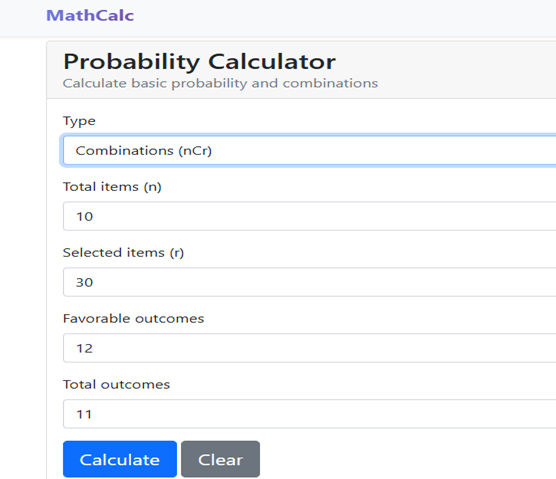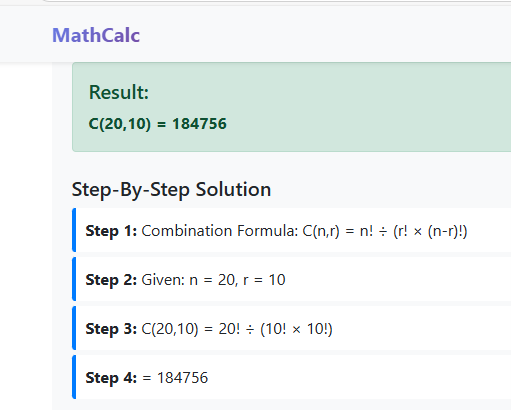Probability Calculator
Have you ever wondered what the probability is that you would win a game, catch the bus at the right time, or have perfect weather for a picnic? You can get answers quickly with the MathCalc Probability Calculator. It will figure it out on its own after you type in the numbers. You don't need to use forms or do anything else.You can use this tool to guess, find answers to both hard and easy questions, or satisfy your curiosity. It's easy to quickly find out how likely it is that one event, a set of events, or even a "what if" situation will happen. So simple that anyone can use it, even if they don't know much about math. Don't assume; use a free online probability tool to find out.
Probability Calculator
Calculate basic probability and combinations
How to Use
- Fill in the Required Values
- Click "Calculate" Button
- View Step-By-Step Solution
How do I use the probability calculator?
1. Choose the type from the list that drops down.
• Basic probability: Figure out how likely it is that something will happen.
• nCr (combination): Find the number of ways to pick r items from n, without taking order into account.
• nPr (Permutation): Figure out how many ways there are to arrange r items from n, taking into account the items.
2. Enter total items (n): This is the total number of items in your set.
3. Enter selected items (r): The number of items you are choosing or arranging.
Important note: (r cannot be greater than n)
• Enter favourable outcomes – The number of outcomes that match your desired event.
• Enter total outcomes – The total number of possible outcomes.

After entering the values, you click on calculate, and in a second, you will see the result.

Example 1: Basic Probability
Question: The room has 5 pink lights and 7 blue lights. What is the probability that you will pick a pink light? Select the type of basic probability.
• Enter total items (n): 12
• Enter selected items (r): 1
• Enter favourable outcomes: 5
• Enter total outcomes: (12)
Solution:
Step-By-Step Solution
Step 1: Basic Probability Formula: P(E) = (Favorable outcomes) ÷ (Total outcomes)
Step 2: Given: Favorable = 5, Total = 12
Step 3: P(E) = 5 ÷ 12 = 0.4167
Step 4: As percentage: 0.4167 × 100 = 41.67%
Result:
Probability: 0.4167
Percentage: 41.67%
Odds: 5:7
Example 2: Combination nCr
Question: How many ways can you choose 3 students from a group of 10?
• Choose the type “combination nCr."
• Enter total items (n): 10
• Enter selected items (r): 3
• Enter "0" in the favourable outcome and selected outcome because our question has no outcomes, but MathCalc has the rule to fill all fields.
Solution:
Step-By-Step Solution
Step 1: Combination Formula: C(n,r) = n! ÷ (r! × (n-r)!)
Step 2: Given: n = 10, r = 3
Step 3: C (10,3) = 10! ÷ (3! × 7!)
Step 4: = 10×9×8×7×6×5×4×3×2×1 ÷ (3×2×1 × 7×6×5×4×3×2×1)
Step 5: = 3628800 ÷ (6 × 5040)
Step 6: = 120
Result:
C (10,3) = 120
Example 3: Permutations (nPr)
Question: How many ways can you arrange 2 books out of a shelf of 6 different books?
• Choose Type nPr
• Enter total items (n): 6
• Enter selected items (r): 2
• Enter "0" in the favourable outcome and selected outcome because our question has no outcomes, but MathCalc has the rule to fill all fields.
Step-By-Step Solution
Step 1: Permutation Formula: P(n,r) = n! ÷ (n-r)!
Step 2: Given: n = 6, r = 2
Step 3: P (6,2) = 6! ÷ 4!
Step 4: = 6×5×4×3×2×1 ÷ 4×3×2×1
Step 5: = 720 ÷ 24
Step 6: = 30
Result:
P (6,2) = 30
How does the MathCalc Work?
The MathCalc Probability calculator finds 3 different types of probability.
• Basic probability: It divides the number of favorable results by the total number of outcomes.
• nCr (Combination): For choices that don't have an order, it uses the formula C (n, r) = n! ÷ (r! × (n-r)!)
• nPr (permutations): The formula is P (n, r) = n! ÷ (n-r)! For arrangements with the order.
Why use the MathCalc probability calculator?
Get Quick Results
The MathCalc probability calculator helps you get results in seconds. Just choose a type and enter the values in all fields. Click on calculate, and you will see the result in seconds. Example: Find the value of nCr for n (10) or r (3). After you enter the values and click the calculate button, you can see the result in a few seconds.
Reduce Human Error
The MathCalc Probability calculator makes sure you always get the right answers. If you want to rock in Maths, use the MathCalc probability tool. Example: If you find nPr of n (6) or r (2) manually, there is a chance of error, but the MathCalc calculator gives you an accurate result in seconds.
FAQ
When should I use nCr or nPr instead of basic probability?
Use nCr when you are selecting items, and the order does not matter. Use nPr when arranging items and the order matters. Calculate the probability of an event occurring using basic probability.
Can we use decimals or percentages instead of whole numbers?
Absolutely! While doing the basic probability, you can enter input as whole numbers, as fractions, or even decimals. The system will calculate the probability of the outcome and present the results in the format you prefer. It can be in whole numbers, fractions, or even decimals.